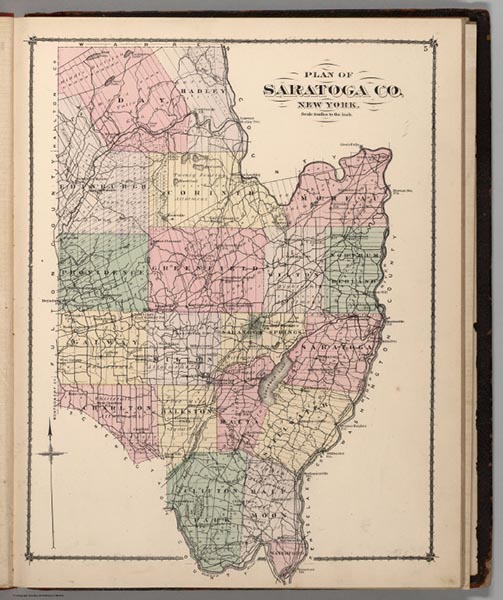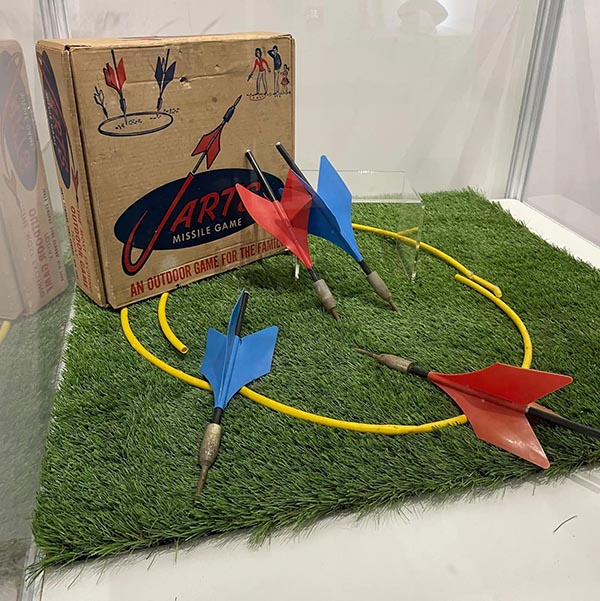Days of Type
Those of you in the design community: have you been a-tingle with excitement for the past month? What? Why should you be? Well, it was the “36 Days of Type,” of course!
36 Days of Type is a project that invites designers, illustrators and visual artists to express their unique interpretation of the letters and numbers of the Latin alphabet.
A yearly open call that explores the creative boundaries of letterforms by challenging participants to design a letter or number each day for 36 consecutive days. The result is a global and simultaneous act that showcases the ability to represent the same symbols from thousands of different perspectives.
This year’s type-fest kicked off April 10 and ends today, May 5. Print magazine had a mid-point round-up of some of this year’s entrants.

Check out the @36DaysOfType Instagram account and hashtag (#36DaysOfType).
Atlases Obscure
Do you like historic maps? If yes, good news! The David Rumsey Map Collection awaits you. The online database offers more than 120,000 downloadable maps and other items, featuring rare maps, cartographers’ charts, and diagrams from all over the world, from the 16th century through to the present day.
The David Rumsey Map Collection was started over 35 years ago and contains more than 150,000 maps. The collection focuses on rare 16th through 21st century maps of North and South America, as well as maps of the World, Asia, Africa, Europe, and Oceania. The collection includes atlases, globes, wall maps, school geographies, pocket maps, books of exploration, maritime charts, and a variety of cartographic materials including pocket, wall, children's, and manuscript maps. Items range in date from around 1550 to the present.
Digitization of the collection began in 1996 and there are now over 121,000 items online, with new additions added regularly. The site is free and open to the public. Here viewers have access not only to high resolution images of maps that are extensively cataloged, but also to a variety of tools that allow users to compare, analyze, and view items in new and experimental ways.

Each download also comes with a text file that offers a complete database entry for the map, including original source, size, scale, complete publishing information, and more. Hours of fun for map lovers!
Edit Menu
If you’re like us, and we know we are, you enjoy trying new restaurants. But sometimes they are not up to par. Is there a way to tell that in advance? Sure, there is Yelp! or other online reviews, but those tend to skew toward either “This place is fantastic!” or “This place is a hellhole!” as people tend to rave about great experiences and complain about bad ones, while just an average, fairly pleasant experience goes unremarked. Anyway, The Guardian’s restaurant criticoffers one particular criterion for evaluating an untested restaurant: typography.
It all starts with the menu, whether viewed online or in the window. Begin with the basics, by which I mean the typeface. Dismiss anywhere that uses comic sans or the like. If they have so little taste in typography, what hope is there when it comes to the food? Equally, be suspicious of somewhere that uses a grandiose italic. Aside from the fact that they’re so bloody hard to read, it’s also a clear signifier: it says “we take food Seriously” with a capital S. Is that your idea of fun? No? Move on. A menu should be physically readable.
Then there is the quality of the writing.
Are they using redundant adjectives? If the menu feels the need to tell you that the squid is tender, find somewhere else. No restaurant intentionally serves rubbery squid. So why the hell are you telling me that yours is tender? Look out for other terrifying words. Are ingredients “nestled”? Is the dish “sumptuous”? Are there “medleys” or “symphonies”? If anything is described as “mouth-watering”, close down the browser. Back away from the window. Whoever wrote that menu is desperately overcompensating for deficiencies in the kitchen. A good menu should also be simply written.
Then there are the graphics.
Study the photographs that are available online. Does the look of the restaurant seem to match the cost? We are deeply into the subjective here, but there is now so much online you have significant evidence to go on. Does anybody in those pictures look as if they’re having a nice time?
And we have seen photographs in printed menus that were so badly color-managed as to make the food completely unappetizing.
So if you are a restaurant, invest in some professional editorial and graphic design help when creating online or printed menus.
Signs of the Times, Part the Ongoing: The Write Stuff
In 1988, during a Hollywood writer’s strike, Johnny Carson quipped in his opening monologue, “It’s a weird picket line, writers are out there holding these signs, and there is nothing on them.”
Waka waka.
This week, TV and film screenwriters went in strike, and The Guardian has a pictorial roundup of some of the clever picket signs.
The ensuing picket lines in New York and Los Angeles are filled with signs making fun of Netflix, Quibi and greedy executives. But the best material is reserved for ChatGPT: one of the writers’ biggest demands includes a ban on AI generation of scripts for film or television.


Invisible Touch
One display technology that has become fairly ubiquitous, from phones and tablets to printing press control panels, to virtually everywhere is the touch screen. Even post-COVID, we haven’t necessarily seen a drop in touch screens, even on ATMs, which we always found a bit grotty even pre-pandemic. One place, though, we are not fond of touch screens is in the car, for a very basic reason: they require you to take your eyes off the road to adjust something like the heat or A/C (or worse, the infotainment system), where with physical buttons and knobs, it is easy to adjust the controls by feel, at least in a familiar car (shortly after buying a new car, we discovered it not unusual to accidentally turn on the hazard lights while adjusting the temperature—there is a tactile learning curve). It seems that we are not alone in our dislike of automotive touch screens—and car manufacturers are starting to discontinue them. Via Slate:
A growing number of automakers are backpedaling away from the huge, complex touch screens that have infested dashboard design over the past 15 years. Buttons and knobs are coming back.
The touch screen pullback is the result of consumer backlash, not the enactment of overdue regulations or an awakening of corporate responsibility. Many drivers want buttons, not screens, and they’ve given carmakers an earful about it. Auto executives have long brushed aside safety concerns about their complex displays—and all signs suggest they would have happily kept doing so. But their customers are revolting
You said it, they stink on ice. Oh, wait…
which has forced them to pay attention.
Ah.
As with other dangerous trends in car design (see the steering yoke), this one can be traced back to Tesla, which has for years positioned its vehicles as “tablets on wheels.” As a result, touch screens were seen as representing tech-infused modernity.
However, it turns out that cost was a large part of the touch screen takeover.
“These screens are presented as this avant garde, minimalist design,” said Matt Farah, a car reviewer and host of The Smoking Tire, an auto-focused YouTube channel and podcast. “But really, it’s the cheapest way possible of building an interior.” Although they look fancy, Farah said that carmakers can purchase screens for less than $50, making them significantly less expensive than tactile controls.
And they can be unsafe. A study by the AAA Foundation found that “infotainment touch screens can distract a driver for up to 40 seconds, long enough to cover half a mile at 50 mph.” A lot can happen on the road in 40 seconds, especially in Massachusetts.
Carmakers have noticed—and they’ve begun to change their tune. Given the higher costs of using physical controls, it’s unsurprising that Porsche has been at the vanguard, returning buttons to the interior of the 2024 Cayenne. (Bugatti, meanwhile, never adopted touch screens in the first place.) “One would hope that luxury trickles down,” said Farah. “As they reject the screens, it could over time be seen as luxurious to have buttons instead.”
Volkswagen, which owns Porsche, has acknowledged that customer feedback led it to drop its much-loathed steering wheel touch controls that were nearly impossible to use without looking down from the windshield, and executives have suggested adding more buttons to its future EVs.
Good! Bring back buttons and knobs!
Epic Fails
Innovation. It’s what drives progress—and often business. Vendors and others in our industry often refer to their new “innovations,” be it hardware, software, services, etc. But innovation often goes hand-in-hand with failure. And failure often leads to innovation. Historic innovations are often the stuff of museums—and now, so are failures.
The Museum of Failure is “a collection of failed products and services from around the world.” Pre-COVID, the Museum of Failure was a traveling road show that brought its curated collection to various cities. Now, it’s back and it in Brooklyn, N.Y., until June 18. Says Gizmodo:
The museum is a microcosm of failure, of course, but it’s also a display of what was once innovation. Exhibition organizers told Gizmodo during our visit that the goal of the showcase is to recontextualize what failure means—at some point, somewhere all of these projects started as ideas that someone thought could change the world.
Remember the Juicero, an expensive countertop appliance that squeezed juice out of the company’s proprietary juice bags? As it turned out, it was quite possible to squeeze the juice out by hand. Oops. The Hula Chair, which featured a gyrating seat that was supposed to work your core? And Lawn Darts, heavy and pointy toys which resulted in more than 6,000 child injuries. Whoopsie.

You can buy tickets here.
Tape of Good Hope
When you arrange a room, do you take feng shui principles into account? No, nor do we, but if you do, you may appreciate a “feng shui tape measure.” Via Core77:
Known as Lu Ban rulers, they’re named for a historical Chinese architect/builder who lived during the Zhou Dynasty (roughly 2,500 years ago). What differentiates these tapes is that dimensions thought to be auspicious by Feng Shui practitioners (mirroring Western golden ratio believers) are marked in red.

The thinking is that objects ought to be built or placed in space to these red dimensions. Go with the black dimensions and, well, you're taking your chances.
Graphene Gets Its Engines Started
Was it a good week for graphene news? It’s always a good week for graphene news! A graphene-based engine oil additive is said to improve fuel economy, power, and performance, reduce noise and vibration, and extend engine life. The product is called NAMITEC and was developed by E2 Holdings and 2DM. From (who else?) Graphene-Info:
The Company explains that graphene as a lubricating additive can reduce the coefficient of friction due to its capability to produce a nano-bearing protective layer for the moving parts of your engine. SG Graphene NAMITEC engine oil additive is suitable for all gasoline and diesel engines, as well as machinery and tools.
NAMITEC engine oil additive is developed from a proprietary formula and production process to maximize the performance of high purity graphene. NAMITEC is specifically formulated to be extremely low in dosage (10ml additive to 4L of engine oil) for maximum compatibility with different types of engine oil. NAMITEC can easily enter the friction interfaces of an engine due to its nanoparticle size and sheet structure characteristics.
Pawnography
Last week, we included an item about a new Light-Up Chess Set that featured LED-illuminated pieces. But have you ever wondered where chess pieces in general came from and how they got their names? We have, and Big Think has a long article on the history of today’s chess pieces.
The game we know as chess first emerged in India in the early 7th century and was called chaturanga. Designed to represent an Indian battlefield, it took more than a thousand years for it to spread throughout Europe, and finally hit Iceland around 1600 A.D., where it was known as skák. As the game moved west through Arab and Persian cultures, the board and rules remained remarkably consistent, although the identity of some of the pieces changed over the years to reflect local cultures. (For example, why would a 7th-century Indian battlefield have a bishop? And are bishops known for walking diagonally?) Still, many also remained consistent.
The notion of the pawn as a “foot soldier” is fairly consistent throughout the history of chess, with the Indo-European root for “foot” echoing all the way from the original Sanskrit padati, via the Latin pedester to modern French pion (and imported into modern Turkish as piyon) and English pawn.
The horsie has also remained fairly consistent.
From the very beginning of chaturanga, this piece — originally called asva, Sanskrit for “horse” — has firmly maintained its equine association. Of course, this is likely because it is the only piece that is able to jump over the heads of the other pieces. As the map shows, the variation in nomenclature is fairly limited: the piece is either named after the animal (e.g., cavallo in Spanish), its rider (e.g., riddari in Icelandic), or the movement it makes (e.g., springare in Swedish).
As for the rook, that was originally a chariot —ratha in Sanskrit, rukh in Persian. The Persian term spawned the word “rook,” but how did it come to be represented by a tower or castle?
One theory is that the Arabs transmitted the Persian term rukh almost unchanged to Europe, where it turned into old Italian roc or rocco. That’s virtually identical to rocca, the old Italian term for “fortress”, which association in turn gave rise to alternate names for the piece: torre (“tower”) and castello (“castle”).
Another theory is that Persian war chariots were so heavily armored that they resembled small, mobile fortifications — hence the link between rukh and castles.
As for the bishop, that’s a piece that has had a large number of terms and representations over the centuries.
It starts as another elephant, except that this piece was actually called “elephant” in Sanskrit (hasti) and in Persian (pil). That was Arabized as al-fil, which was Latinized as alphilus.
In French, that became fil, fol, and finally fou, which means “fool” or “jester.” That term was the result of a chain of Chinese whispers, which was then faithfully translated into Romanian. Another whisper changed alphilus, which means nothing in Italian, into alfiere, which means “standard bearer” in Italian.
The wide range of this piece’s movements explains terms such as “runner” (e.g., Läufer in German), “hunter” (e.g., lovac in Serbian), “gunner” (e.g., strelec in Slovak), and “spear” (oda in Estonian). The Russians are among those who have maintained the original “elephant,” called slon in Russian. But in the past, it has also been called a durak (“fool”, probably a loan from the French) and an offizer.
It is only in English, Icelandic, Faroese, Irish, and Portuguese that the piece is called a “bishop,” and no one knows why.
The miter-shaped appearance came after the name. The term does have some pedigree: the Lewis chessmen, carved from walrus ivory in the 12th century, already have the bishops dressed in recognizably ecclesiastical garb.
At any rate, if you are a chess fan, click through and read about the other pieces. (Spoiler alert: the queen wasn’t originally a queen.)
Rite of Spring
Earlier this week was May Day, and one celebration that often gets lumped in with May Day festivities is Beltane. (Maybe not in the US, but in Ireland and Scotland it tends to be more popular.) Celebrated around April 30/May 1, Beltane is a celebration of renewal, featuring bonfires, flowers, dancing, May Queens, Green Men, and other general whooping-it-up. Historically, though, it was a celebration of something a bit more prosaic: animal husbandry. We’re not sure we want to know how that would translate into a modern celebration, but, anyway, says Atlas Obscura:
Travel back about 6,000 years, to the time when hunter-gatherers across Northern Europe were starting to settle down. Agriculture, spreading north and west across the continent, had arrived. People living in what’s now Ireland and the United Kingdom were starting to sow crops and raise livestock. With this lifestyle shift came a new focus on charting the seasons to regulate farming and herding activities. Over millennia, early agrarians around the world, from China to Mesopotamia, developed regional agricultural calendars based on the movement of the heavens, most commonly the sun and moon, and the ancient people living in the British Isles were no different.
There were celebrations of the solstices and equinoxes, but also “quarter days” which occur halfway between a solstice and an equinox. The most popular quarter (or cross-quarter) day falls between the fall equinox and the winter solstice: Samhuinn, aka Samhain, aka Halloween, which marked the imminent arrival of winter. Then there was the quarter day of Imbolc halfway between the winter solstice and the vernal (spring) equinox which marked the start of lambing season and was a precursor to today’s Groundhog Day, as people were getting a bit sick of winter. There was also Lughnasadh, or Lúnasa, the quarter day halfway between the summer solstice and autumn equinox that heralded the start of harvest time, but it doesn’t seem to have inspired any modern versions.
Then there was Beltane, the quarter day halfway between the spring equinox and summer solstice (around May 5 or 6), which heralded the start of summer. This was the most important quarter day for the ancient agrarians.
In The Encyclopedia of Celtic Mythology and Folklore, Patricia Monaghan wrote that Beltane “was essentially an agricultural festival,” and marked the time when cattle, particularly important in ancient Ireland, were driven from sheltered winter locations to buaile, summer pastures bright with fresh grass. She noted that the famous fires of Beltane, now associated with purification, “may have originated simply in the need to burn off brush before the fields and pastures were put into use.”
Beltane also marked the start of the growing season in earnest.
All of Beltane’s other elements, from purification to often lusty rituals around fertility, were layered on top of its original purpose on the agricultural calendar. Celebrating Beltane would have been a “luxury” for the early agrarians, whose main concerns were “the practicalities of producing food for survival,” Trevarthen wrote in a paper on the agricultural, pre-Celtic origins of Beltane, published in Cosmos, the journal of the Scotland-based Traditional Cosmology Society.
As calendar systems were standardized across Europe, Beltane was moved up to April 30/May 1 so that it corresponded with other flower-and-fire festivals like Central Europe’s Walpurgisnacht.
So. Beltane. It’s all about the cows.
A Distillery to Remember
Do you like whiskey? The Titanic? If yes, and if you’re in Belfast any time soon, be sure to stop in at the Titanic Distillery, which is a Titanic-themed whiskey distillery actually located in what had been the Thompson Graving Dock and Pumphouse, which opened in 1911 to serve as a repair and maintenance shop for White Star Line, owner of the Titanic. In addition to tastings, you can also choose from four different tours of the historic building. Says Food & Wine:
The different tour options include its Signature Tour, which shows off the distillery and brings guests to its tasting room for a dram of its Premium Irish Whiskey and Premium Irish Vodka, and its Premium Tour, which offers the same but with a take-home limited-edition glass. There’s also the Dock Tour, which provides the “unique opportunity to explore the site where Titanic last rested,” and the Legacy Tour, an extended tour of the dock led by an expert guide to answer every question along the way.
(The article headline claims it is a gin distillery, which it is not and probably is more of an indication of what the headline writer had been drinking.)
The Titanic distillery started welcoming guests on April 28.
It’s probably a safe bet they’d prefer not to serve their whiskey on ice.
Cap in Hand
Do like wearing baseball caps, but wish they offered better protection from the sun than a visor? Well, then this is for you: a baseball cap that features a flip down pair of sunglasses. Via Core77:

If this is your thing, and you prefer the safety of Amazon’s return policy, they cost $12.29 on Amazon. If you want to gamble, they’re $10.79 on AliExpress and a worryingly low $4.27 on Temu.
All three of those prices include free shipping from China, and I just don’t know how that’s possible.
Dessert—It’s What’s for Breakfast
Some of us here in the Around the Web Cultural Accretion Bunker remember when Cookie Crisp cereal was introduced in 1977. Cookies? For breakfast?! It seemed like a crazy idea that no parent would approve of (they did), but the trend toward turning candies and the like into breakfast cereals has only continued. Reese’s Puffs? Drumstick ice cream cones? We’re not sure this fosters healthy eating habits for kids, but now there is a new dessert breakfast: Kit Kat cereal. Says Food & Wine:
General Mills Kit Kat Cereal aims to capture the taste and texture of the candy bar’s signature crispy wafers covered in milk chocolate in a spoonable format. The cereal’s squares even resemble miniature Kit Kat bars with a chocolatey coating and crunchy bite.

General Mills is rolling out new cereal products and snacks based on fan-favorite brands throughout 2023. Earlier this year, it unveiled miniature cereal versions of Reese’s Puffs, Cinnamon Toast Crunch, and Trix cereals. This month, they released two new mini cereal additions: Lucky Charms Minis and Cocoa Puffs Minis.
It’s all happening in the cereal aisle.
And this spring, the company is also set to release Cinnamon Toast Crunch Tres Leches, Vanilla Spice Cheerios, Golden Grahams and Cinnamon Toast Crunch flavors of Soft Baked Oat Bars, plus a non-breakfast snack: Cinnamon Toast Crunch Dunkaroos. The latter treat is a twist on the resurrected cookie and frosting packs, which originally debuted in 1992.
Did anything catch your eye “around the Web” this week? Let us know at [email protected].
This Week in Printing, Publishing, and Media History
May 1
1753: Publication of Species Plantarum by Linnaeus, and the formal start date of plant taxonomy adopted by the International Code of Botanical Nomenclature.
1786: In Vienna, Austria, Mozart’s opera The Marriage of Figaro is performed for the first time.
1840: The Penny Black, the first official adhesive postage stamp, is issued in the United Kingdom.
1971: Frank Romano’s national holiday—Amtrak (the National Railroad Passenger Corporation) takes over operation of U.S. passenger rail service.
1999: SpongeBob SquarePants premieres on Nickelodeon after the 1999 Kids’ Choice Awards.
2002: Dr. Joe Webb’s national holiday—OpenOffice.org releases version 1.0, the first stable version of the software.
May 2
1519: Italian painter, sculptor, and architect Leonardo da Vinci dies (b. 1452).
1611: The King James Version of the Bible is published for the first time in London, England, by printer Robert Barker.
1885: American actress and gossip columnist Hedda Hopper born.
1895: American playwright and lyricist Lorenz Hart born.
1952: The world’s first ever jet airliner, the De Havilland Comet 1 makes its maiden flight, from London to Johannesburg. (Certain airlines are still using it...)
1955: Tennessee Williams wins the Pulitzer Prize for Drama for Cat on a Hot Tin Roof.
2000: Rand McNally’s national nightmare—President Bill Clinton announces that accurate GPS access would no longer be restricted to the United States military.
2012: A pastel version of The Scream, by Norwegian painter Edvard Munch, sells for $120 million in a New York City auction, setting a new world record for a work of art at auction.
May 3
1469: Italian historian and philosopher Niccolò Machiavelli born.
1913: Raja Harishchandra, the first full-length Indian feature film is released, marking the beginning of the Indian film industry.
1935: American businessman and founder of the Ronco Company Ron Popeil born. But wait! There’s more!
1952: The Kentucky Derby is televised nationally for the first time, on the CBS network.
1957: Walter O’Malley, the owner of the Brooklyn Dodgers, agrees to move the team from Brooklyn to Los Angeles.
1958: Danish-English comedian, author, and radio host Sandi Toksvig born.
1959: English actor, director, and screenwriter Ben Elton born.
1960: The Off-Broadway musical comedy The Fantasticks opens in New York City’s Greenwich Village, eventually becoming the longest-running musical of all time.
1965: Welsh actor and comedian Rob Brydon born.
1973: The 108-story Sears Tower (now officially the Willis Tower) in Chicago is topped out at 1,451 feet as the world's tallest building.
1978: The first unsolicited bulk commercial email (which would later become known as “spam”) is sent by a Digital Equipment Corporation marketing representative to every ARPANET address on the west coast of the United States.
May 4
1939: Israeli journalist and author Amos Oz born.
1953: Ernest Hemingway wins the Pulitzer Prize for The Old Man and the Sea.
1959: The 1st Grammy Awards are held.
1972: The Don't Make A Wave Committee, a fledgling environmental organization founded in Canada in 1971, officially changes its name to “Greenpeace Foundation.”
May 5
1809: Mary Kies becomes the first woman awarded a U.S. patent, for a technique of weaving straw with silk and thread.
1813: Danish philosopher and author Søren Kierkegaard, born.
1835: The first railway in continental Europe opens between Brussels and Mechelen.
1864: American journalist and author Nellie Bly born.
1866: Memorial Day first celebrated in United States at Waterloo, N.Y.
1891: The Music Hall in New York City (later known as Carnegie Hall) has its grand opening and first public performance, with Tchaikovsky as the guest conductor.
1905: The trial in the Stratton Brothers case begins in London, England; it marks the first time that fingerprint evidence is used to gain a conviction for murder.
1912: Pravda, the “voice” of the Communist Party of the Soviet Union, begins publication in Saint Petersburg.
1927: Semi-colon lovers’ national holiday—To the Lighthouse by Virginia Woolf is first published.
1943: English actor and screenwriter Michael Palin born.
1959: English singer-songwriter and guitarist Ian McCulloch born.
2001: American publisher, creator of CliffsNotes Clifton Hillegass dies (b. 1918).
2020: The National Telecommunications Commission issued a cease and desist order to ABS-CBN to stop the operations of its free TV and radio stations one day after their 25-year congressional franchise was expired.
May 6
1536: King Henry VIII orders English-language Bibles be placed in every church. In 1539 the Great Bible would be provided for this purpose.
1835: James Gordon Bennett, Sr. publishes the first issue of the New York Herald.
1840: The Penny Black postage stamp becomes valid for use in the United Kingdom of Great Britain and Ireland.
1862: American essayist, poet, and philosopher Henry David Thoreau dies (b. 1817).
1889: Typographer, known for work on Times New Roman font, Stanley Morison born.
1915: American actor, director, producer, and screenwriter Orson Welles born.
1940: John Steinbeck is awarded the Pulitzer Prize for his novel The Grapes of Wrath.
1949: EDSAC, the first practical electronic digital stored-program computer, runs its first operation.
1960: American singer-songwriter and guitarist (They Might Be Giants) John Flansburgh born.
May 7
1539: Italian printer Ottaviano Petrucci dies (b. 1466).
1711: Scottish economist, historian, and philosopher David Hume born.
1812: English poet and playwright Robert Browning born.
1824: World premiere of Ludwig van Beethoven’s Ninth Symphony in Vienna, Austria.
1840: Russian composer and educator Pyotr Ilyich Tchaikovsky born.
1846: The Cambridge Chronicle, America’s oldest surviving weekly newspaper, is published for the first time in Cambridge, Mass.
1952: The concept of the integrated circuit, the basis for all modern computers, is first published by Geoffrey Dummer.










Discussion
Join the discussion Sign In or Become a Member, doing so is simple and free